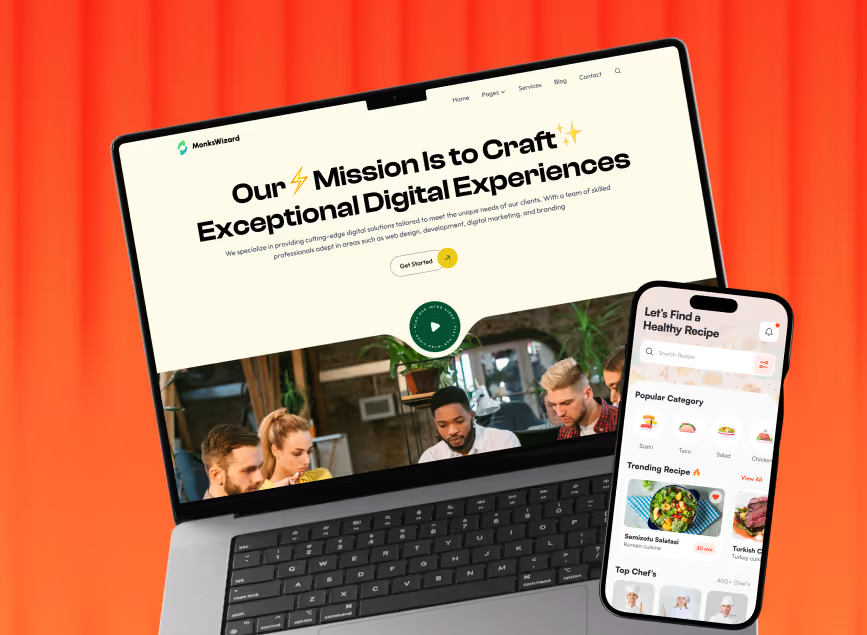
Key Takeaways
- Startup design strategies align user needs with business goals effectively.
- Clear design improves focus, speeds processes, and reduces costly revisions.
- Consistent branding builds trust, recognition, and long-term customer loyalty.
- User-centric design ensures products solve real problems and engage audiences.
- Structured design strategy guides execution, saving time, money, and resources.
Planning your startup must be quite exciting for you with new ideas and possibilities. But if you think startup design strategies are optional, you're setting yourself up for tough times ahead.
A great product or service alone won’t carry you to success. How you present and design it is pretty important. Design strategies for startups are the blueprint that connects your brand’s identity with user needs and business goals.
Without a proper business design strategy, your startup risks confusion, inconsistency, and missed growth opportunities. Don't want this nightmare to be true? Then keep reading and learn everything about this fact.
What Do the Design Strategies for A StartUp Mean?
Design strategies for a startup are plans that help the business succeed by using smart design choices. These strategies help you build products or services in a way that meets both the customer’s needs and the business's goals.

In simple terms, a design strategy for a startup guides how it should approach creating its products. It's all about deciding on the steps, tools, and processes the team will follow in product development that not only look good but also solve real problems and attract customers.
This strategic solution helps owners set priorities and organize work more efficiently. Also, it makes sure that everyone involved in the design process works toward the same vision.
For a startup, this solution means focusing on how the design will help grow the business, keep customers happy, and stand out from competitors.
Why Does Your Startup Need a Design?
For sure, starting your own business is an exciting journey until you hit the first bump. Well, if you’re not paying attention to design from day one, you might hit a lot of bumps together.

Good design isn’t just about making things look cool, it’s about setting up your startup for success. Let's learn why design should be your first priority from the start:
Helps You Create Product Designs that People Want
Startup UX design is all about understanding your users. It's essential to know what your audience actually needs and values, especially to create product designs that solve real problems.
Instead of shooting in the dark, you should build something that resonates with customers. Design helps you put the user first, so you can make things that people truly want.
Speeds up Your Process And Keeps Everyone Focused
When your team is on the same page about design, things move faster. With a clear design vision in place, you cut down on unnecessary discussions and get straight to execution.
In such an environment, everyone knows what the goals are. As a result, there’s less back-and-forth and more progress. A focused design process means faster results and fewer hold-ups.
Makes Entrepreneurial Work Smarter & Saves Money
A solid business strategy can save you a lot of headaches along with some cash. By planning out your design properly from the beginning, you can avoid costly changes and revisions later.
When the design is done right from the start, it streamlines your workflow efficiently. At the same time, it prevents expensive mistakes to save your startup both time and money.
Attracts Top Talent and Investors
Great design doesn’t just grab the notice of the customers, it also catches the eye of potential team members and investors. A well-designed product guarantees that you’re serious about what you’re building. This attention to detail can attract the right people to join your team or invest in your startup.
Keeps Your Brand Memorable and Consistent
Good UX design makes sure your brand looks and feels the same in everything. Whether it’s your website, product, or marketing materials, consistency is a must to make your brand succeed. When customers recognize your brand instantly, it creates trust and keeps you on top of your mind, and that helps you build a lasting presence.
So, if you want your startup to get people's notice and revenue quickly, you can't overlook startup design strategies. It’s not just a "nice-to-have" anymore, especially in this competitive market. It has become mandatory to set your business up for long-term success.
Create a Design Strategy for Your Startup in 7 Steps
How well your brand’s identity aligns with your business goals depends on how well you develop a design strategy for your startup. It also helps your business to resonate with your target market.

However, you might be thinking about how to create a structured design strategy, right? Learn it in seven simple steps right below:
Step 1: Define Your Business Goals
Start by clearly defining what you want to achieve. You should have clear design objectives. This could be like boosting revenue, improving customer engagement, or expanding your reach.
Your design strategy should support these goals. These measurable objectives will guide your design efforts and make sure your team stays focused on what really matters.
Step 2: Research Your Market and Audience
You need to understand your industry and customers to create product designs or services that users truly want. Conduct UX research to analyze what’s working for competitors.
It's also important to identify gaps where your startup can stand out. Your design choices should be informed by this user research. Just make sure that your decisions speak to the right audience and have a meaningful impact.
Step 3: Establish a Strong Brand Identity
Always remember that your brand is the face of your startup. That's why you should have a proper branding plan. Take the time to define your brand’s mission, vision, and personality.
Think about some questions, like What makes you different? How do you want people to think about your business? Once you get the answers, it will be easier to create a brand-style guide. This guide must reflect your unique identity to help keep your branding consistent on all platforms.
Step 4: Create a Standardized Project Brief
To keep things organized and develop a detailed project brief for each design work initiative. This document should cover your objectives, target audience, scope of work, and key deliverables.
A clear brief ensures everyone understands the goals and expectations from the beginning. This approach makes the design process smoother and more efficient.
Step 5: Generate Ideas and Develop Concepts
Then, you should gather your startup team for brainstorming sessions. This is necessary because the session will help you come up with creative ideas that align with your business goals and brand identity.
Try to involve your team properly and explore multiple directions. Encourage them to provide feedback and refine your concepts before moving on to execution. This is where your design decisions start to take shape.
Step 6: Execute the Design
Once you’ve finalized your concepts, it’s time to bring them to life. Use appropriate design tools to create high-quality and polished visuals that stick to your brand guidelines.
Here, the most important fact is consistency. At any cost, you need to ensure that every design, whether for your website, social media, or product packaging, looks unified and professional.

Step 7: Finalize and Launch
Once designs are approved, prepare the final files for different platforms, like print, digital, or web. Don't forget to guide how to implement these designs effectively. This guidance will ensure a smooth rollout on different marketing channels. A well-executed launch will amplify your startup’s presence and keep the momentum going.
These seven steps might not seem easier if you are not involved with the designing section. So, what to do? The answer is hiring the best UX design agency that you can trust. However, going through all these steps is necessary to create a design strategy that will perfectly shape your visual identity and your overall business goals.
Marketing Design for Startups
For startups, marketing design isn’t just about visuals, it’s about clarity, consistency, and connection. A strong design communicates your brand message instantly and builds trust from the very first glance.
Start with a clear brand identity. Your logo, color palette, and typography should be aligned with your mission and values. This identity should carry across all your marketing touchpoints, from social media to pitch decks.
Next, focus on user-centric design. You can get idea from some ideal UX design inspirations. Whether it’s a landing page, ad creative, or email campaign, every element should be simple, scannable, and actionable. Highlight your product’s core value, not just features.
Design also plays a key role in storytelling. Use visuals to support your message, explain complex ideas, and guide the user journey.
In the early stages, great marketing design helps startups stand out in a crowded space by turning curiosity into conversion. It’s not just how it looks, but how well it works.

FAQs
How does design strategy differ from business strategy?
A design strategy focuses on how design choices align with both user needs and business goals. Also, it guides visual and product development.
A business strategy, on the other hand, is a broader aspect that covers the overall goals of the business. It focuses on the market positioning and growth plans. Design strategy complements business strategy by shaping the user experience and brand perception.
What are the 4 principles of design strategy?
The four core principles of design strategy are:
- Alignment (ensuring design supports business goals),
- Empathy (focusing on user needs),
- Simplicity (making designs easy to use and understand), and
- Consistency (maintaining uniform design elements across all touchpoints to create a cohesive brand identity).
How often should a design strategy be updated?
Design strategies should be updated as your startup gets developed. You should update it particularly when there are major changes in your business goals, market conditions, or user feedback. Regular reviews ensure that the strategy stays relevant and continues to align with both business and user needs.
How does a design strategy impact brand identity?
A design strategy shapes the visual elements of a brand like color schemes, typography, and imagery. Maintaining consistency on all touchpoints reinforces brand recognition and helps communicate your startup’s personality, values, and message to customers more effectively.
How to Design a Startup?
To design a startup, identify a real problem, validate your idea, define your target audience, build a minimal viable product (MVP), test often, iterate based on feedback, and focus on solving user pain points effectively.
End Note
A well-developed startup design strategies is undoubtedly a must-have for startups that want to build a strong brand identity, engage users, and grow effectively. It aligns design efforts with business goals to ensure that every visual and product decision serves a purpose.
You should focus on user needs, maintaining consistency, and innovation, to keep your startup competitive and scalable. Additionally, develop the design strategies in a way that effectively optimizes workflows, saves resources, and provides a clear direction according to market changes.

.svg)






.avif)
.avif)
.avif)
.avif)


.avif)
.avif)
.avif)
.avif)


.avif)




